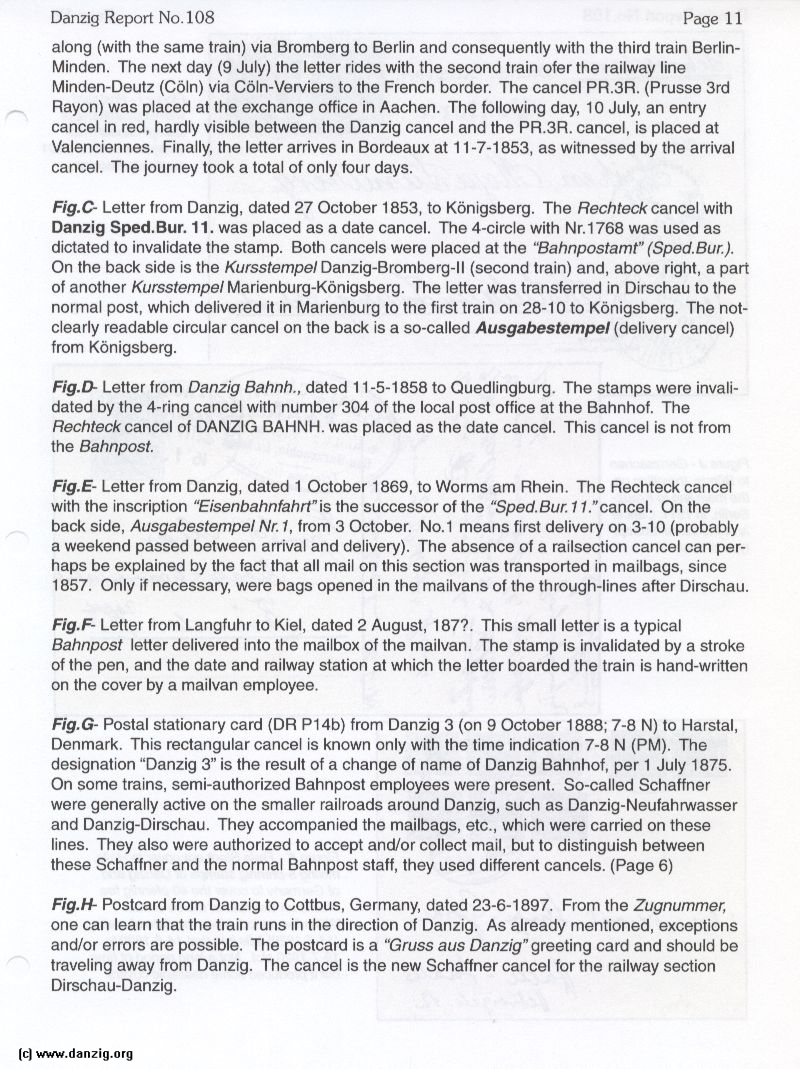
along (with the same train) via Bromberg to Berlin and consequently with the third train BerlinM inden. The next day (9 July) the letter rides with the second train ofer the railway line Minden-Deutz (Coin) via Côln-Verviers to the French border. The cancel PR.3R. (Prusse 3rd Rayon) was placed at the exchange office in Aachen. The following day, 10 July, an entry cancel in red, hardly visible between the Danzig cancel and the PR.3R. cancel, is placed at Valenciennes. Finally, the letter arrives in Bordeaux at 11-7-1853, as witnessed by the arrival cancel. The journey took a total of only four days.
Fig.C- Letter from Danzig, dated 27 October 1853, to Kanigsberg. The Rechteck cancel with Danzig Sped.Bur. 11. was placed as a date cancel. The 4-circle with Nr.1768 was used as dictated to invalidate the stamp. Both cancels were placed at the Bahnpastamt” (Sped.Bur.). On the back side is the Kursstempel Danzig-Bromberg-ll (second train) and, above right, a part of another Kursstempei Marienburg-KOnigsberg. The letter was transferred in Dirschau to the normal post, which delivered it in Marienburg to the first train on 28-10 to Königsberg. The not- clearly readable circular cancel on the back is a so-called Ausgabestempel (delivery cancel) from Konigsberg.
Fig.D- Letter from Danzig Bahnh., dated 11-5-1858 to Quedlingburg. The stamps were invalid ated by the 4-ring cancel with number 304 of the local post office at the Bahnhof. The Rechteck cancel of DANZIG BAHNH. was placed as the date cancel. This cancel is not from the Bahnpost.
Fig.E- Letter from Danzig, dated 1 October 1869, to Worms am Rhein. The Rechteck cancel with the inscription “Eisenbahnfahrt”is the successor of the “Sped.Bur. 1 1.”cancel. On the back side, Ausgabestempel Nr. 1, from 3 October. No.1 means first delivery on 3-10 (probably a weekend passed between arrival and delivery). The absence of a railsection cancel can perh aps be explained by the fact that all mail on this section was transported in mailbags, since 1857. Only if necessary, were bags opened in the mailvans of the through-lines after Dirschau.
Fig.F- Letter from Langfuhr to Kiel, dated 2 August, 187?. This small letter is a typical Bahnpost letter delivered into the mailbox of the mailvan. The stamp is invalidated by a stroke of the pen, and the date and railway station at which the letter boarded the train is hand-written on the cover by a mailvan employee.
Fig.G- Postal stationary card (DR P14b) from Danzig 3 (on 9 October 1888; 7-8 N) to Harstal, Denmark. This rectangular cancel is known only with the time indication 7-8 N (PM). The designation “Danzig 3” is the result of a change of name of Danzig Bahnhof, per 1 July 1875. On some trains, semi-authorized Bahnpost employees were present. So-called Schaffner were generally active on the smaller railroads around Danzig, such as Danzig-Neufahrwasser and Danzig-Dirschau. They accompanied the mailbags, etc., which were carried on these lines. They also were authorized to accept and/or collect mail, but to distinguish between these Schaffner and the normal Bahnpost staff, they used different cancels. (Page 6)
Fig.H- Postcard from Danzig to Cottbus, Germany, dated 23-6-1897. From the Zugnummer, one can learn that the train runs in the direction of Danzig. As already mentioned, exceptions and/or errors are possible. The postcard is a “Gruss aus Danzig”greeting card and should be traveling away from Danzig. The cancel is the new Schatfner cancel for the railway section Dirschau-Danzig.
Danzig Report Vol. 1 - Nr. 108 - July - August - September - 2000, Page 11.
Hits: 4091
Added: 28/07/2015
Copyright: 2025 Danzig.org

